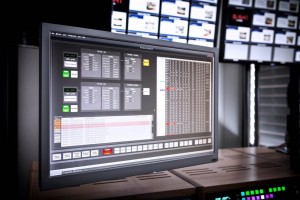SVG Europe Sit-Down: Axon’s Jan Eveleens discusses software solutions, SMPTE 2110 and cyber security
This year sees Axon celebrate its 30th anniversary as a broadcast infrastructure specialist. Obviously, the industry has changed dramatically in three decades, and today the company looks very much at developing products and solutions designed to help broadcasters handle the challenges of the move to IP.
At BVE 2017, the company showed its latest monitoring and control software Cerebrum, the 4K IP Multiviewer and AZilPIx its multi-camera capture and production system.
In this interview, Jan Eveleens, who has been with Axon since 2009, reflects on what IP means to the industry, plus the challenges and the way forward.
What differences has the increasing use of remote sports production made to Axon?
At present, we are not seeing any dramatic differences and we cannot really pinpoint specific impacts. The workflows of our customers have always changed and evolved over time and we have continuously adapted to those changes. However, when the application of IP becomes mainstream, we do expect an acceleration in demand for products that support this. The move to IP will streamline remote production by reducing the amount of cables needed, eliminating racks of cumbersome kit and creating more space in the OB unit. What customers will need instead is an agile and robust control and monitoring system that supports a hassle-free, flexible creative workflow. This is something we already offer with Cerebrum, which has back-end IP integration, as well as an impressive, flexible front-end, thus giving customers the ability to manage complex sports productions such as The Open Golf Championship or UEFA Europe League football with ease.
With a move to more software-centric solutions, what role does open source have to play?
Open Source is already important – and has been so for some time. In recent years, we have ensured that many of our products use Linux and related open software so that they are as accessible as possible. The importance of open source will only increase as products become more Ethernet/IP and software centric. It is all about focussing on the added value you can deliver to your customers. Using existing Open Source (or licensed) software enables you to get a product out to market as quickly as possible.
In your experience, is there still a lack of understanding about the use of software solutions?
For many people, software solutions are still seen as being less reliable or more ‘buggy’. However, what many customers do not realise is that most of today’s hardware product are actually software/firmware products operating on a bespoke rather than general purpose hardware platform. Customers also struggle with recognising the value of software-only based solutions, compared to the same functionality running on dedicated hardware. Somehow, the software-only based solution is expected to be significantly cheaper, whereas this really should not be the case.
Are you happy with the progress of work on SMPTE 2110? Are you involved in any way?
We follow this process quite closely through our membership of AIMS and we are implementing the standard in parallel with its creation, so we should have compatible products once the standard is finalised. Compared to many other SMPTE standards this is on a fast track and will be concluded in record time.
Cyber-security is, of course, a major issue. How are you reassuring customers in this regard?
Our advice is always to use the best tools, technologies and practices that are already available. Businesses, such as banking, that moved into IP some time ago see cyber security as just as important as we do, therefore they have devoted time and energy into creating highly effective mechanisms to ensure customer safety – all of which are available for our industry to tap into. However, we do need to be careful because most of the first-generation systems that are now coming to market won’t have the necessary ‘hooks’ and provisions to implement these existing tools and technologies. For this reason, broadcasters should be cautious about exposing their video over IP networks to the open internet.
How do you see UHD developing as far as your product range is concerned?
UHD is growing part of our product portfolio and we expect this growth to accelerate in the next few years as it becomes more mature and as more and more customers start experimenting with and launching mainstream UHD services. We certainly expect growth to accelerate when the situation around HDR becomes clearer, something we anticipate happening during 2017.
Finally, any future plans you are free to discuss?
There is no doubt that IP will become the backbone of our industry because, and with protocol enhancements, it will prove more convenient, more flexible and eventually cheaper than SDI. But until those benefits can be easily delivered, our strategy remains customer-focused, pragmatic and format-agnostic. We are committed to delivering the products and hybrid/bridge solutions that broadcasters need to move from SDI to IP, but we are also working on next generation products where Ethernet is the default interface.
A good example of this is our new 8-channel bi-directional NIO440 that provides the bridge from 3G/HD-SDI to uncompressed Ethernet video transport and de-centralised routing. It can be used as a point to point video/audio/data connection – using standard fibre-optic cables or SMPTE camera cables, avoiding CWDM infrastructures and cost. In addition, it provides point to multi-point routing and distribution using IT switches. At present, the card is compatible with both AVB/TSN and s2022. Future standards like VSF-TR03/TR04 – and of course SMPTE-2059 – are also within its capability and compatibility will be achieved by future software upgrades.



